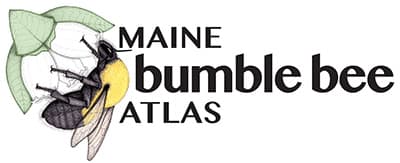Home → Fish & Wildlife → Community Science Projects → Maine Bumble Bee Atlas
Maine Bumble Bee Atlas

Bumble bees are one of our most important pollinators of both wild and cultivated flowering plants. Their early emergence and "buzz pollination" method are especially beneficial to many spring wildflowers and valuable Maine crops, like apples, blueberries, cranberries, and tomatoes. Unfortunately, over the past 20 years, some species of bumble bees have declined throughout their ranges and several have all but disappeared. Habitat loss, pesticides, diseases and parasites introduced with commercially-raised bumble bees, and intensive agricultural practices likely all play a role in bumble bee declines worldwide.
To better understand the diversity, distribution, and conservation status of Maine's native bumble bee fauna, MDIFW initiated the Maine Bumble Bee Atlas (MBBA) project in 2015. Designed as a five-year statewide survey and coordinated by the Department in partnership with the University of Maine, MBBA enlists the aid of volunteers from all over the state to collect data on what species are present, where they occur, what habitats they use, and how abundant they are. During the project's first three years, over 230 participants were trained in a standardized survey protocol. This enthusiastic group of citizen scientists went to work and, by the end of the third field season, contributed more than 17,000 new bumble bee records! Their data show that 13 of the 17 species historically known to occur in Maine are still present, and some species have decreased in abundance while others have increased.
Four previously documented species have not yet been found during MBBA surveys. All four have declined in other parts of their range and it is possible they are now extirpated from Maine. One species, the Rusty Patched Bumble Bee, has declined by 90% throughout its entire North American range and in 2017 became the first bumble bee to be protected by the U.S. Endangered Species Act. While this species has not been seen in Maine for about a decade, we are still hopeful that one of our MBBA volunteers will discover a remnant population. With two more seasons of data to collect, there is still much to discover and learn about Maine's bumble bees and their conservation needs.
For more information about the Maine Bumble Bee Atlas, visit the project website at mainebumblebeeatlas.umf.maine.edu/ and follow us on Facebook at facebook.com/MaineBumblebeeAtlas.
This work is supported by the federal State Wildlife Grants program, in-kind contributions from the University of Maine at Orono and Farmington, the Maine Outdoor Heritage Fund, state revenues from the Loon Conservation Plate and Chickadee Check-off Funds, and volunteer assistance from citizen scientists.